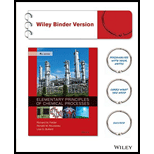
Concept explainers
(a)
Interpretation:
The time interval after which the trap discharges is to be determined.
Concept introduction:
A flowchart is the complete representation of a process through boxes or other shapes which represents process units and arrows that represents the input and output of the process. The flowchart must be fully labelled to infer important data about the process involved.
In a system, a conserved quantity (total mass, mass of a particular species, energy or momentum) is balanced and can be written as:
Here, ‘input’ is the stream which enters the system. ‘Generation’ is the term used for the quantity that is produced within the system. ‘Output’ is the stream which leaves the system. ‘Consumption’ is the term used for the quantity that is consumed within the system. ‘Accumulation’ is used for the quantity which is builds up within the system.
All the equations which are formed are then solved simultaneously to calculate the values of the unknown variables.
The equation for energy balance is:
Here,
(b)
Interpretation:
The yearly cost of the leaks based on
Want to see the full answer?
Check out a sample textbook solution
Chapter 7 Solutions
Elementary Principles of Chemical Processes, Binder Ready Version
- 11:01 ☑ canvas.ucsd.edu 口 : ... Page 1 > of 2 Q - ZOOM + 4. Consider the two separate sets of measured data for a silt-loam soil measured by Mualem (1976): (1) suction versus water content, and (2) suction versus relative permeability of unsaturated soil, k/ks. Assume that 0s 0.396, 0res = 0.131, and Ks=5.74×10-7 m/s. a. Using the method of least squares in Excel, compute the best-fit values for αNG (kPa¹) and nvg for the van Genuchten (1980) relationship for data set # 1 (assume m = 1-1/nvG). See the example spreadsheet in the homework folder under the files section of Canvas for help in performing this calculation. b. Repeat part (a) and estimate the λ and ac parameters for the Brooks and Corey (1964) SWRC for data set #1. Note that you may need to include an "if" statement at the air entry suction. c. Plot the data for the SWRC versus the fitted van Genuchten (1980) and Brooks and Corey (1964) curves. Which relationship matches the capillary pressure data better (BC or VG)? Explain…arrow_forwardSolve h.w 6arrow_forwardSolve this questionarrow_forward
- Solve this questionarrow_forwardthe answer is shown but i dont know how to get to itarrow_forward1. (20 points) Steam (6000 kg/h, 10 bar, 400°C) is passed through an adiabatic turbine that drives a shaft to generate power. The steam leaving the turbine is at 0.5 bar and passes to a chiller where heat is removed at the rate of 1.25 x 107 kJ/h. Saturated liquid leaves the chiller at 0.5 bar. (a) How much work (kW) is produced in the turbine? (b) What is the quality of steam leaving the turbine? Sometimes, steam produced is 'wet' in nature, and is composed of saturated water vapor and entrained water droplets. In such cases, quality is defined as the fraction of steam that is vapor.arrow_forward
- WLV2 | Online teaching and × + w.com/ilrn/takeAssignment/takeCovalentActivity.do?locator-assignment-take A १ eq eq eq [Review Topics] [Referen Draw the structure of 3,3-dimethylbutanal in the window below. • In cases where there is more than one answer, just draw one. 985 + / $ Sn [ ] ChemDoodle ? req Submit Answer Retry Entire Group 8 more group attempts remaining req req Cengage Learning Cengage Technical Supportarrow_forwardA flat-sheet membrane of thickness, L, and surface area, S, separates two fluids (see figure). The concentration on the upstream side is maintained at C_A0 while that on the downstream side is maintained at zero. The membrane is loaded with an immobilized enzyme that converts substrate A to product B according to a zero order reaction mechanism given by:R_A=-k_0"' (d) What is the flux, N_A, at the downstream surface (z=L)? (e) Under what condition will the flux at z=L be equal to zero? (f) At the condition in (e), what can you say about the diffusion time relative to the reaction time?arrow_forwardDevelop a purification train for a facility where first process is a perfusion upstream bioreactors 500L producing low cell culture titer of approx. 0.5 g/L perfusing at 2 VVD over 30 days. The current facility has a secondary clarification process for the perfusate coming from the bioreactor. Secondary depth filtration clarification capacity of 200 L/m2. Identify the correct filter area, and system (pump) requirements for the process scale. Also identify optimal flowrates for flushing and processing, total process time, buffer volumes required. Assume 10 L/m2 holdup of the depth filters identify the size of the tank required to collect the filtrate. Average yield of overall clarification is 80% estimate the titer in the clarified pool.arrow_forward
 Introduction to Chemical Engineering Thermodynami...Chemical EngineeringISBN:9781259696527Author:J.M. Smith Termodinamica en ingenieria quimica, Hendrick C Van Ness, Michael Abbott, Mark SwihartPublisher:McGraw-Hill Education
Introduction to Chemical Engineering Thermodynami...Chemical EngineeringISBN:9781259696527Author:J.M. Smith Termodinamica en ingenieria quimica, Hendrick C Van Ness, Michael Abbott, Mark SwihartPublisher:McGraw-Hill Education Elementary Principles of Chemical Processes, Bind...Chemical EngineeringISBN:9781118431221Author:Richard M. Felder, Ronald W. Rousseau, Lisa G. BullardPublisher:WILEY
Elementary Principles of Chemical Processes, Bind...Chemical EngineeringISBN:9781118431221Author:Richard M. Felder, Ronald W. Rousseau, Lisa G. BullardPublisher:WILEY Elements of Chemical Reaction Engineering (5th Ed...Chemical EngineeringISBN:9780133887518Author:H. Scott FoglerPublisher:Prentice Hall
Elements of Chemical Reaction Engineering (5th Ed...Chemical EngineeringISBN:9780133887518Author:H. Scott FoglerPublisher:Prentice Hall
 Industrial Plastics: Theory and ApplicationsChemical EngineeringISBN:9781285061238Author:Lokensgard, ErikPublisher:Delmar Cengage Learning
Industrial Plastics: Theory and ApplicationsChemical EngineeringISBN:9781285061238Author:Lokensgard, ErikPublisher:Delmar Cengage Learning Unit Operations of Chemical EngineeringChemical EngineeringISBN:9780072848236Author:Warren McCabe, Julian C. Smith, Peter HarriottPublisher:McGraw-Hill Companies, The
Unit Operations of Chemical EngineeringChemical EngineeringISBN:9780072848236Author:Warren McCabe, Julian C. Smith, Peter HarriottPublisher:McGraw-Hill Companies, The





